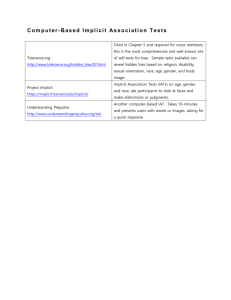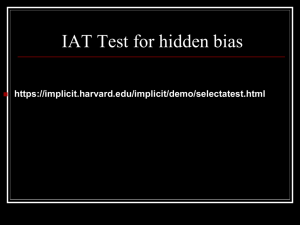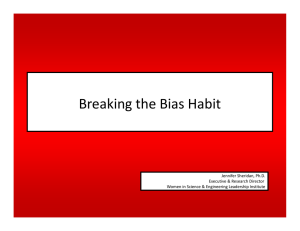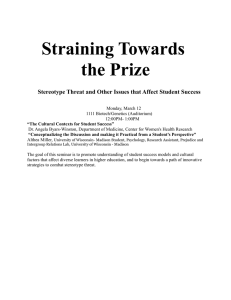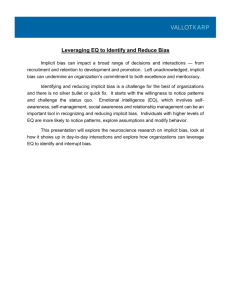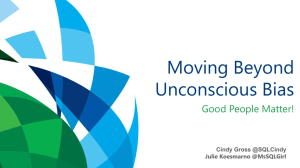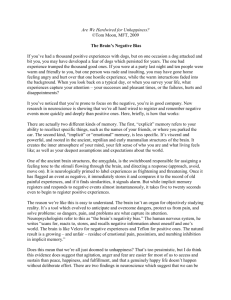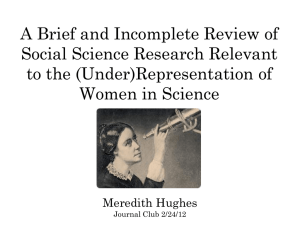Women in STEM: Understanding and Minimizing The Role of Implicit Bias
advertisement
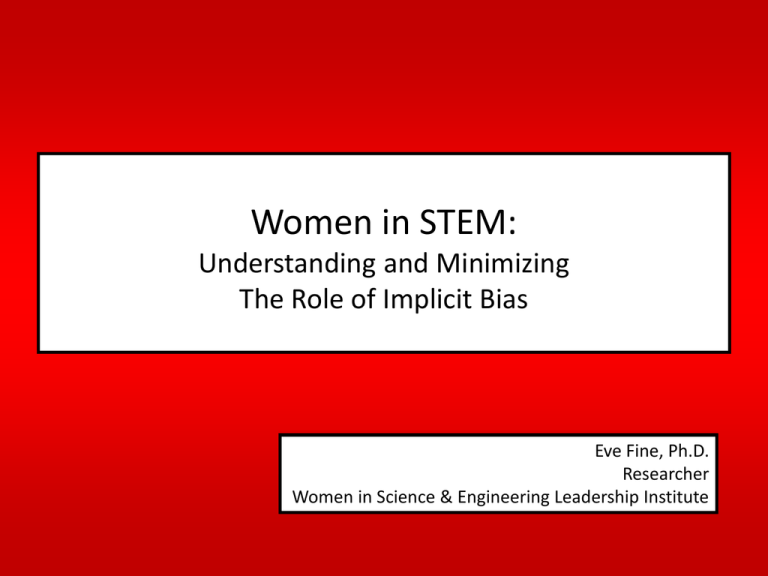
Women in STEM: Understanding and Minimizing The Role of Implicit Bias Eve Fine, Ph.D. Researcher Women in Science & Engineering Leadership Institute % Women receiving science and engineering degrees, 1966-2010 60.00% 50.00% % Women 40.00% 30.00% Bachelors Masters PhD 20.00% 10.00% 0.00% Source: National Science Foundation S&E Degrees Percent Women - Bachelor's degrees 70.00% 60.00% 40.00% Biological Sciences Mathematics and Statistics 30.00% Chemistry Astronomy 20.00% 10.00% Source: National Science Foundation S&E Degrees 2012 2010 2008 2006 2004 2002 2000 1998 1996 1994 1992 1990 1988 1986 1984 1982 1980 1978 1976 1974 1972 1970 1968 0.00% 1966 Percent Women 50.00% Percent Women - Bachelor's degrees 70.00% 60.00% Biological Sciences 40.00% Mathematics and Statistics Chemistry 30.00% Physics Astronomy Engineering 20.00% 10.00% Source: National Science Foundation S&E Degrees 2012 2010 2008 2006 2004 2002 2000 1998 1996 1994 1992 1990 1988 1986 1984 1982 1980 1978 1976 1974 1972 1970 1968 0.00% 1966 Percent Women 50.00% Percent Women - Bachelor's degrees 70.00% 60.00% 50.00% Mathematics and Statistics 40.00% Chemistry Physics 30.00% Astronomy Computer Science 20.00% Engineering 10.00% Source: National Science Foundation S&E Degrees 2012 2010 2008 2006 2004 2002 2000 1998 1996 1994 1992 1990 1988 1986 1984 1982 1980 1978 1976 1974 1972 1970 1968 0.00% 1966 Percent Women Biological Sciences Percent Women PhDs and Faculty, 2007 60 50 Percent Women 40 PhD, 2004-06 30 Asst. Prof. Assoc. Prof. Full Prof. 20 10 0 Astronomy* Biological Sciences Chemistry Computer Science Math Physics Source: Faculty Data – Nelson Diversity Surveys, 2007; PhD data – National Science Foundation S&E Degrees *For all disciplines except Astronomy, the faculty data are for the top 100 departments in each discipline as ranked by NSF on research spending. NSF only ranks 40 Astronomy departments Why do you think it is important to have a diverse faculty and student body in science and engineering; to have better representation of women and minorities in science? Why Diversity? • Diverse working groups are more productive, creative, and innovative than homogeneous groups • Diverse groups engage in a higher level of critical analysis than do homogeneous groups • Diverse scholars and professionals can invigorate and expand disciplines and fields • Mentors and role models for all • Fairness and equity Why do you think women and minorities are underrepresented in many STEM disciplines – especially in faculty ranks? Why the Lack of Representation? • Bias/discrimination • Lack of encouragement for women and URM in STEM • Lack of role models/mentors • Microaggressions – and/or Negative/chilly climate women and minorities experience as students/faculty • Societal factors including K-12 schooling, social expectations, career advice • Women: Difficulty balancing work and family life Why the Lack of Representation? What’s not on the list: • Innate/biological differences in intellectual ability • Lack of interest in science What is Implicit Bias? • A substantial body of evidence demonstrates that most of us routinely rely on unconscious assumptions even though we intend to be fair and believe that we are fair. • Depending on the discipline, unconscious biases can also be referred to as: Schemas Stereotypes Mental models Cognitive shortcuts Statistical discrimination Implicit associations Spontaneous trait inference System 1 thinking The tendency of our minds to apply characteristics of groups (real or imagined) to our judgments about individual group members. What is Implicit Bias? • Human brain works by categorizing people, objects and events around us -- this allows us to quickly and efficiently organize and retrieve information. • These ordinary, necessary mental operations usually serve us well … but they are subject to error and can fail our intentions. • When evaluating people we can be led astray by our tendency to categorize people – and we tend to do so on the following dimensions: Race/Ethnicity, Sex, and Age. Examples of how ordinary, necessary mental operations can be subject to error Stereotypes about men? Men • • • • • • Strong Decisive Independent Logical/Rational Lack emotions Good at math Stereotypes about women? Men • • • • • • Strong Decisive Independent Logical/Rational Lack emotions Good at math Women • • • • • • Nurturing Nice Supportive/Helpful Emotional Sympathetic Verbal Stereotypes about scientists? Stereotypes about engineers? Men • • • • • • Strong Decisive Independent Logical/Rational Lack emotions Good at math Women “Scientist” ? • • • • • • Nurturing Nice Supportive/Helpful Emotional Sympathetic Verbal Men • • • • • • Strong Decisive Independent Logical/Rational Lack emotions Good at math Women “Engineer” ? • • • • • • Nurturing Nice Supportive/Helpful Emotional Sympathetic Verbal Men • • • • • • Strong Decisive Independent Logical/Rational Lack emotions Good at math Women “Leader” ? • • • • • • Nurturing Nice Supportive/Helpful Emotional Sympathetic Verbal Measuring Unconscious Bias: Gender-and-Leadership IAT Gender-and-Science IAT Logic of the IAT • IAT provides a measure of the strength of associations between mental categories such as “male or female” and attributes such as “leader or supporter,” and “science or humanities” disciplines • Strength of association between each category and attribute is reflected in the time it takes to respond to the stimuli while trying to respond rapidly • Trial Types Congruent Trials Say “LEFT” for Leader OR Men Say “RIGHT” for Supporter OR Women Congruent Trials Say “LEFT” for Science OR Men Say “RIGHT” for Humanities OR Women Incongruent Trials Say “LEFT” for Leader OR Women Say “RIGHT” for Supporter OR Men Incongruent Trials Say “LEFT” for Science OR Women Say “RIGHT” for Humanities OR Men IAT Effect Incongruent Trials Congruent Trials 300 Reaction time in ms 250 200 150 100 169 ms IAT Effect: Incongruent – Congruent 50 0 The larger the difference, the greater the bias in associating men with leaders/science and women with supporters/humanities Gender-Leadership IAT Scores 71% 8% D 72% 8% D Gender-Science IAT Scores Female Respondents 8000 16000 7000 14000 6000 12000 Number of Respondents Number of Respondents Male Respondents 70% 5000 4000 3000 2000 8000 6000 4000 1000 0 71% 10000 2000 11% -100 -50 0 150 388 Im plicit Science=Male / Arts=Fem ale Stereotyping 0 10% -100 -50 0 150 388 Im plicit Science=Male / Arts=Fem ale Stereotyping Influence of Implicit Bias on Women in STEMM Implicit bias has consequences for “evaluators” and for individuals being evaluated. Consequences for “evaluators” • Parents/teachers/counselors provide help, mentoring, and advice based on assumptions of students’ interests & abilities -- may steer women away from “male” or “intellectually challenging” fields or toward jobs more closely aligned with stereotypes. • Evaluators view credentials in ways that conform to gender role expectations. Implicit Bias: Hiring a Lab Manager • 127 faculty from Physics, Chemistry and Biology departments • Evaluated an application from an undergraduate science student for an entry-level Lab Manager. – – – – – Competence Hireability Likability Starting Salary Willingness to Provide Mentoring • Application randomly assigned name “Jennifer” or “John” C.A. Moss-Racusin, J.F. Dovidio, V.L. Brescoll, M.J. Graham & J. Handelsman. (2012). Science Faculty’s Subtle Gender Biases Favor Male Students. PNAS 109 (41), 16474-16479. Moss-Racusin et al. 2012. Implicit Bias: Hiring a Lab Manager Mentoring Questions – How likely are you to: • Encourage the applicant to stay in the field if s/he was considering changing majors? • Encourage the applicant to continue to focus on research if s/he was considering switching focus to teaching? • Give the applicant extra help if s/he was having trouble mastering a difficult concept? C.A. Moss-Racusin, J.F. Dovidio, V.L. Brescoll, M.J. Graham & J. Handelsman. (2012). Science Faculty’s Subtle Gender Biases Favor Male Students. PNAS 109 (41), 16474-16479. Minimizing Implicit Bias in Evaluation • More information about individual applicants minimizes bias • Individuation minimizes bias – Establish rapport and professional relationships with faculty – Work in a lab/seek out internships – Networking Influence of Implicit Bias on Women in STEMM Implicit bias has consequence for “evaluators” and for individuals being “evaluated.” Consequences for individuals being “evaluated” • Stereotype Threat • Individuals may “choose” jobs/fields of study that conform to the stereotypes of their group • Individuals may drop out of fields they have chosen due to lack of encouragement/sense of not belonging Stereotype Threat Members of negatively stereotyped groups may underperform when reminded of their group membership Multiple Studies of Stereotype Threat • Black students’ taking GRE Verbal – under two conditions: testing intellectual ability vs. testing psychological factors involved in solving verbal problems. Steele, C. M., & Aronson, J. (1995). Stereotype threat and the intellectual test performance of African Americans. Journal of Personality and Social Psychology, 69(5), 797–811. • Asian women taking a difficult mathematics test –primed to think about their ethnic identity vs. primed to think about their gender identify. Shih, M., & Pittinsky, T. L. (1999). Stereotype susceptibility: Identity salience and shifts in quantitative performance. Psychological Science, 10(1), 80–83. • White men students at Stanford U. with high scores on the math SAT took a challenging math test under two conditions – primed with information Asian students perform better than White students on tests of math ability vs. no priming. Aronson, J., & Lustina, M. J. (1999). When white men can’t do math: Necessary and sufficient factors in stereotype threat. Journal of Experimental Social Psychology, 35(1), 29–46. Stereotype Threat: Images in science textbooks • 81 9th- and 10th grade students (29 male, 52 female) – never taken a chemistry course • Read a section of a chemistry text under 3 conditions: – Only male scientists pictured (stereotypic) – Only female scientists pictures (counter-stereotypic) – Both male and female scientists pictured Good, J.J., J.A. Woodzicka, & L.C. Wingfield. (2010). The Effects of Gender Stereotypic and Counter-Stereotypic Textbook Images on Science Performance. Journal of Social Psychology 150(2), 132-147. Stereotype Threat: Images in science textbooks Good, J.J., J.A. Woodzicka, & L.C. Wingfield. (2010). The Effects of Gender Stereotypic and Counter-Stereotypic Textbook Images on Science Performance. Journal of Social Psychology 150(2), 132-147. Stereotype Threat When Choosing a Major • 39 undergraduate students, non-declared major • Entered room in two conditions: – Stereotypical computer science objects – Non-stereotypical objects • Filled out a career assessment questionnaire – included measuring level of interest in taking a course or majoring in computer science Cheryan, S., V.C. Plaut, P. Davies, & C.M. Steele. (2009). Ambient Belonging: How Stereotypical Cues Impact Gender Participation in Computer Science. Journal of Personality and Social Psychology 97, 1045-1060. Images used with permission of Dr. Sapna Cheryan Images used with permission of Dr. Sapna Cheryan Images used with permission of Dr. Sapna Cheryan Strategies to Reduce the Influence of Implicit Bias/Stereotype Threat • Knowledge Johns, M., Schmader, T., & Martens, A. (2005). Knowing is half the battle: Teaching stereotype threat as a means of improving women’s math performance. Psychological Science, 16(3), 175–179. • Growth Mindsets (vs. fixed mindsets) http://mindsetonline.com • Sense of Belonging – Microenvironments – small study groups with mostly female peers DasGupta, N., McManus Scircle, M., & Hunsinger, M. (2015) Female peers in small work groups enhance women’s motivation, verbal participation, and career aspirations in engineering. PNAS, 112(10): 40888-4993. – Role models – Images/awareness of women scientists/engineers and their accomplishments Good, C., Rattan, A., & Dweck, C. S. (2012). Why Do Women Opt Out? Sense of Belonging and Women’s Representation in Mathematics. Journal of Personality & Social Psychology, 102(4), 700– 717. http://www.reducingstereotypethreat.org/reduce.html Strategies to Reduce the Influence of Implicit Bias/Stereotype Threat Strategies to reduce stereotype threat (Cont.) • Priming with positive counter-stereotypic images • Values Affirmation Cohen, G. L., Garcia, J., Apfel, N., & Master, A. (2006). Reducing the racial achievement gap: A social-psychological intervention. Science, 313(5791), 1307–1310. Harackiewicz, J. M., Canning, E. A., Tibbetts, Y., Giffen, C. J., Blair, S. S., Rouse, D. I., & Hyde, J. S. (2014). Closing the Social Class Achievement Gap for First-Generation Students in Undergraduate Biology. Journal of Educational Psychology, 106(2), 375– 389. • Stereotype Replacement McGlone, M. S., & Aronson, J. (2007). Forewarning and Forearming Stereotype-Threatened Students. Communication Education, 56(2), 119–133. Minimizing the influence of bias • Not necessarily easy • With effort (awareness, motivation, and a sustained commitment), bias can be reduced – Can expect that you may slip up – Stay committed • Strategies we provided are powerful tools to combat implicit biases – Implicit responses can be brought into line with explicit beliefs and commitments
